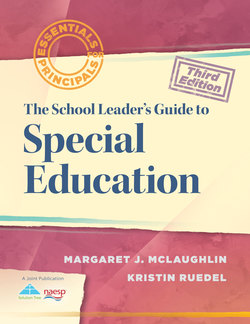Читать книгу School Leader's Guide to Special Education, The - Margaret J. McLaughlin - Страница 5
На сайте Литреса книга снята с продажи.
ОглавлениеTABLE OF CONTENTS
About the Authors
Introduction: The Principal’s Role in the Special Education Process
1 Understanding the Basic Rights of Students With Disabilities
Free Appropriate Public Education
Least Restrictive Environment
Related Services
Procedural Protections for Parents and Students
Due Process Under IDEA
Alternative Dispute Resolutions
Expedited Due Process
Students With Disabilities and No Child Left Behind
Highly Qualified Special Education Teacher
Section 504 of the Rehabilitation Act and the Americans With Disabilities Act
Section 504
Americans With Disabilities Act
2 Determining Who Is Eligible for Special Education
Identification and Evaluation of Students
What Is Child Find?
Must Parents Consent to Evaluation?
Who Is Involved in Conducting an Evaluation?
The Components of an Evaluation
Reevaluation or Triennial Assessments
Response to Intervention
What Is Response to Intervention?
Types of RTI Models
RTI and Specific Learning Disabilities
Implementing RTI in the School
3 Developing and Implementing an Individualized Education Program
What Must an IEP Include?
General Requirements
Setting
Supplementary Aids and Services
Developing IEP Goals
Standards-Based Goals
Who Is Required to Be Part of the IEP Team?
Parent Participation in the IEP Process
The Role of the Principal in the IEP Process
Implementing the IEP
4 Assessing and Teaching Students With Disabilities
Accommodations and Modifications
Assessments
Creating Effective and Inclusive Special Education
Inclusive Education
Effective Instruction and Practices
Collaborative or Co-Teaching
Providing Options for More Individualized Instruction
Effective Classroom Strategies
Teacher Professional Development
5 Discipline and Positive Behavior Interventions and Supports
IDEA Discipline Procedures
Reporting to Law Enforcement Agents or Juvenile Authorities
Zero-Tolerance Policies
Functional Behavioral Assessments
Behavior Intervention Plans
Promoting Positive Behavior: Heading Off Problem Behaviors
6 Encouraging Parental Involvement
Communications With Parents
Effective Strategies to Promote Communication
Building Partnerships With Parents
Conclusion: Final Thoughts for School Leaders
Appendix A: Online Resources
Appendix B: Summary of Significant Changes in IDEA 2004
Glossary
References and Resources
Index
